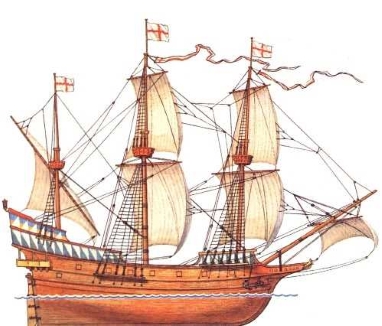Topic: Reprisal Ventures

"galeona" from http://www.piratskelode.wz.cz - wikimedia commons
During the reign of Elizabeth I, England struggled to bring goods to markets controlled by Spain in the New World. Heavily-armed English galleons and support ships dared those forbidden waters and forced the locals at gunpoint to trade with them. Later, as relations deteriorated between England and Spain, Elizabeth commissioned privateers to attack Spanish ships and settlements and bring her a share of the plunder to replenish her coffers.
Those sailing as privateers for the English Crown were granted a "letter of reprisal" so they would not be prosecuted for piracy by the High Court of Admiralty upon their return, so long as they only attacked the nations identified in the letter. The individuals granted these letters were typically sea-captains sailing under joint stock companies financed by private investors.
The word reprisal was appropriated by England's Admiralty Court to describe government-sanctioned pirate raids sailing out of English ports. The use of the word "reprisal" was for progaganda purposes as it implied the aggressive actions were retaliations for previous acts of violence perpetrated by the targeted nation. A vessel sailing under the protection of a letter of reprisal was known as a "ship of reprisal," and the associated private venture was known as a "reprisal venture." In later centuries, the terms "privateer" or "privateering" were used to describe these ships and their activities, because private parties were involved. The term "letter of marque" eventually replaced letter of reprisal.
In addition to furthering her foreign policy aims through privateering, the Queen often gained monetarily because she was due a one-third share of any profits. The Queen at times even lent her own funds and a royal ship or two for reprisal ventures. The privateering voyages generally entailed commerce raiding, but often resulted in the burning, plundering and ransoming of enemy coastal settlements. These were clearly acts of war, prompting the Queen to grant legal cover to her volunteer privateers. Those privateers unfortunate enough to be caught by the enemy were treated as pirates and often executed or enslaved, although some wealthy or famous individuals might be ransomed. This was a high-stakes game, not for the timid or the risk averse.
Other nations used a similar system. The French called their privateers "corsairs" (derived from a latin word for a sea route or "course"). French privateers were issued a "lettre de Course" which was the same as a letter of reprisal. Most of the famous French "pirates" of the early 16th century who plundered Spanish ships and towns in her far-flung empire were technically corsairs, not pirates, since they were acting under the authority of their kings in furtherence of France's perennial wars with Spain.
Queen Elizabeth started commissioning privateers early in her reign, though she always denied it when confronted. On occasion she temporarily curtailed the practice during periods of delicate diplomacy. At times she gained spectacular profits. The English seafarers who engaged in privateering were colloquially known as "sea dogs." Many of these men and their ships participated in the Battle of the Spanish Armada in 1588, supplementing a core force of 22 royal galleons with an additional 180 armed (auxiliary) merchant ships. Without the sea dogs, the English never could have mounted an adequate challenge to the Armada.
For more reading on this topic, I recommend an excellent article appearing in Worldhistory.org https://www.worldhistory.org/article/1576/the-sea-dogs---queen-elizabeths-privateers/ .
